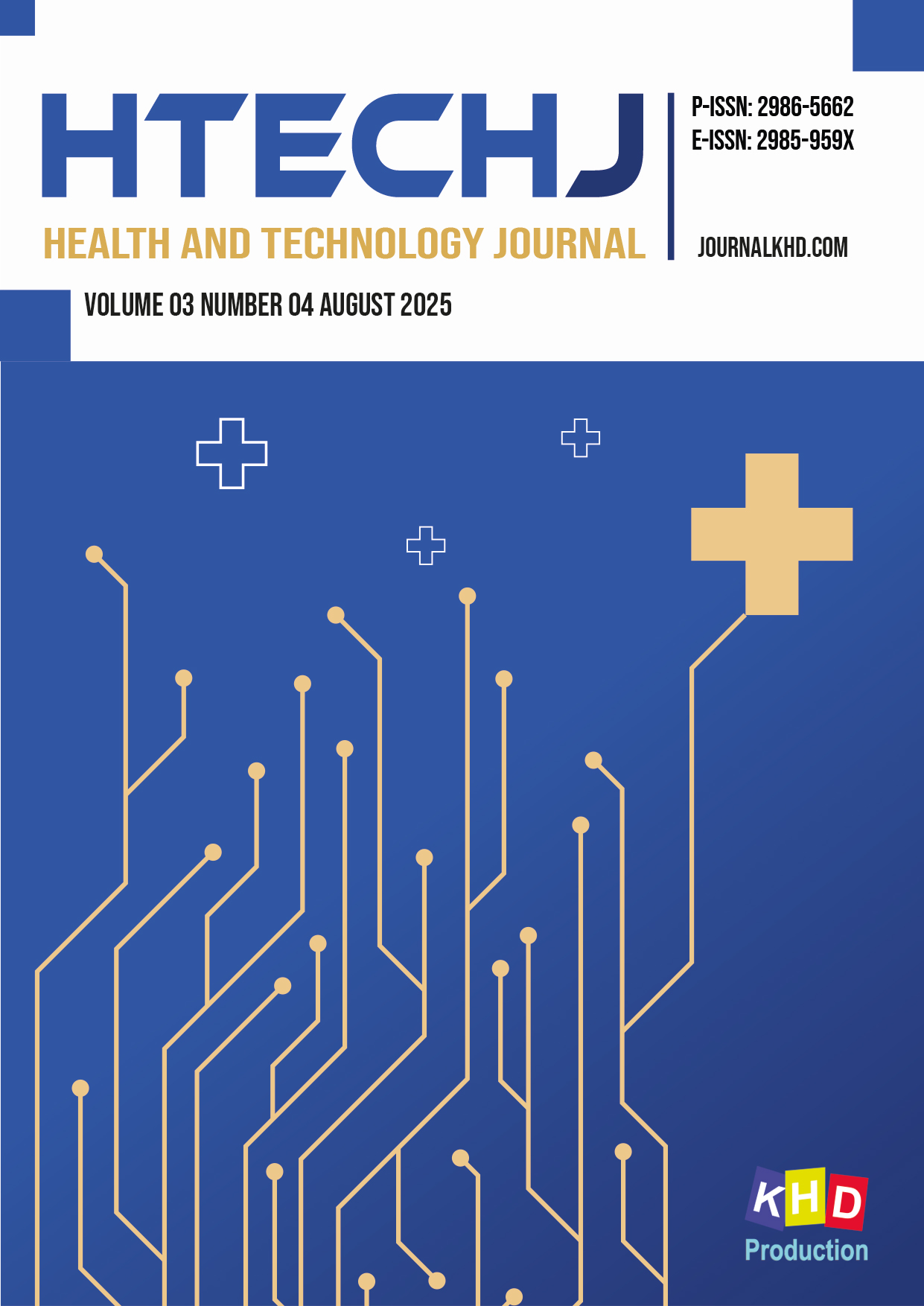A Caring Approach to Families with Pregnant Women in the Third Trimester Regarding Clean and Healthy Living Behavior in Efforts to Prevent Stunting
DOI:
https://doi.org/10.53713/htechj.v3i4.395Keywords:
stunting, third trimester pregnancy, caring, clean and healthy living behaviorAbstract
Stunting remains a serious challenge in Indonesia, particularly during the third trimester of pregnancy, a critical period for fetal growth. This study aims to analyze the application of a caring approach to families with pregnant women in their third trimester to improve Clean and Healthy Living Behavior (CHLB) as an effort to prevent stunting in Sebangau District. The study was conducted over six months in 2025 using qualitative and quantitative descriptive approaches. Data were collected through participatory observation, in-depth interviews, documentation, and questionnaires distributed to pregnant women and family members. Samples were taken purposively, involving intervention and control groups in six urban villages. Data analysis was conducted using descriptive methods and Principal Component Analysis (PCA) to identify the main components influencing the effectiveness of the caring approach to CHLB and the risk of stunting. The results show that the application of caring dimensions such as emotional, social, and empowerment support has a positive effect on improving CHLB in pregnant women. The dominant influencing factors are family empathy, communication with health workers, and access to sanitation facilities. In conclusion, a caring approach in families can improve CHLB in pregnant women and has significant potential in preventing stunting during pregnancy. The recommendation of this research is the need for integration of caring approaches in public health promotive and preventive programs, as well as the development of caring-based family intervention models that can be implemented at local and national levels.
References
Alifatin, A. (2022). Modeling and Role-Modeling Theory on Stunting Children in the Perspective of Philosophy. Preprints. https://doi.org/10.20944/preprints202206.0194.v1
Carolin, Bunga Tiara, Vivi Silawati, Siti Nurendah, and Shinta Novelia. 2023. “The Effectiveness of Giving Fe Tablets With Tomato Juice on Hemoglobin Levels in Third Trimester Pregnant Women With Anemia”. Nursing and Health Sciences Journal (NHSJ) 3 (2):184-87. https://doi.org/10.53713/nhsj.v3i2.205
Ellina, A. D., Nursalam, N., Yunitasari, E., & Adiutama, N. M. (2022). Evaluation of Quality of Nursing Work-Life: Based on Swanson’s Theory of Caring. Open Access Macedonian Journal of Medical Sciences, 9(T5), 185–189. https://doi.org/10.3889/oamjms.2021.7844
Hadiyanti, P., Irvansyah, A., Sasmita, K., Dalimunthe, H. H. B., & Affandi, M. (2024). The Impact of Dialogical Approaches in Extension Programs on Changing Mothers' Behavior for Stunting Prevention in Rural Areas. Edukasi, 18(2). https://doi.org/10.15294/edukasi.v18i2.13610
Kim, S., Kim, G., Lee, W., & Park, J. (2020). Developing an Internet-Based Trauma Recovery Nursing Intervention Based on Swanson’s Theory of Caring for Trauma Recovery. International Journal of Environmental Research and Public Health, 18(13), 6715. https://doi.org/10.3390/ijerph18136715
Mårtensson, S., Hodges, E. A., Knutsson, S., Hjelm, C., Broström, A., Swanson, K. M., & Björk, M. (2021). Caring Behavior Coding Scheme based on Swanson’s Theory of Caring – development and testing among undergraduate nursing students. Scandinavian Journal of Caring Sciences, 35(4), 1123-1133. https://doi.org/10.1111/scs.12927
Mulyani, A. T., Khairinisa, M. A., Khatib, A., & Chaerunisaa, A. Y. (2024). Understanding Stunting: Impact, Causes, and Strategy to Accelerate Stunting Reduction—A Narrative Review. Nutrients, 17(9), 1493. https://doi.org/10.3390/nu17091493
Nastiti, A. D., Puspitasari, R. H., Handayani, D., & Rahmad Irwansyah, F. (2025). The Effect of Moringa Leaf Fortification on Improving the Nutritional Status of Stunting Toddlers in Coastal Areas. Health and Technology Journal (HTechJ), 3(2), 180–188. https://doi.org/10.53713/htechj.v3i2.338
Nurhaeni, N., Huda, M. H., Chodidjah, S., Agustini, N., Waluyanti, F. T., K. Nadi, H. I., Sri Armini, N. K., Sari, M., & Jackson, D. (2024). Exploring the strategies and components of interventions to build adolescent awareness about stunting prevention in West Java: A qualitative study. PLOS ONE, 19(12), e0314651. https://doi.org/10.1371/journal.pone.0314651
Prihayati, Wasis Sembada, L., & Ramayulis, R. (2024). The Relationship between Clean Water Facilities, Building Conditions, and Toilet Ownership with Events Stunting among Months Toddlers in The Working Area of The Taktakan Public Health Center. Health and Technology Journal (HTechJ), 2(3), 302–307. https://doi.org/10.53713/htechj.v2i3.183
Ritanti, & Farah Aprilia. (2024). The Relationship Between Maternal Characteristics and Family Health Tasks With the Incident of Stunting in Toddlers in Depok City. Nursing and Health Sciences Journal (NHSJ) 4 (4):472-81. https://doi.org/10.53713/nhsj.v4i4.431.
Saleh, A., Syahrul, S., Hadju, V., Andriani, I., & Restika, I. (2020). Role of Maternal in Preventing Stunting: A Systematic Review. Gaceta Sanitaria, 35, S576-S582. https://doi.org/10.1016/j.gaceta.2021.10.087
Setiawan, A. S., Indriyanti, R., Suryanti, N., Rahayuwati, L., & Juniarti, N. (2022). Neonatal stunting and early childhood caries: A mini-review. Frontiers in Pediatrics, 10, 871862. https://doi.org/10.3389/fped.2022.871862
Setiawati, A., Batticaca, F., Biduri, E., Kana, M., & Menga, M. (2025). Community Nurses’ Strategies for Overcoming Stunting Through a Family Approach. Jurnal Ilmiah Kesehatan Sandi Husada, 14(1), 45-54. https://doi.org/10.35816/jiskh.v14i1.1246
Shenoy, S., Sharma, P., Rao, A., Aparna, N., Adenikinju, D., Iloegbu, C., Pateña, J., Vieira, D., Gyamfi, J., & Peprah, E. (2023). Evidence-based interventions to reduce maternal malnutrition in low and middle-income countries: A systematic review. Frontiers in Health Services, 3, 1155928. https://doi.org/10.3389/frhs.2023.1155928
Soliman, A., Sanctis, V. D., Alaaraj, N., Ahmed, S., Alyafei, F., Hamed, N., & Soliman, N. (2021). Early and Long-term Consequences of Nutritional Stunting: From Childhood to Adulthood. Acta Bio Medica : Atenei Parmensis, 92(1), e2021168. https://doi.org/10.23750/abm.v92i1.11346
Suhardin, S., Suwetty, A. M., Lede, M. E. H. ., Riantiarno, F. ., Mella, O. ., & Banamtuan, D. A. . (2024). Family Experiences in Caring for Children with Stunting in Timor, East Nusa Tenggara, Indonesia: A Family-Centered Nursing Approach. Journal of Current Health Sciences, 4(1), 49–58. https://doi.org/10.47679/jchs.202486
Umar, F. (2021). Family Centered Approaches to Stunting Prevention. Journal of Health Literacy and Qualitative Research, 1(2), 84-98. https://doi.org/10.61194/jhlqr.v1i2.532
Wijaya, M. I. (2024). Social Ecological Approach to Combating Stunting in Kintamani, Bali, Indonesia. Universal Journal of Public Health. 12(5), 799 - 810. https://doi.org/10.13189/UJPH.2024.120502
Yusriadi, Y., Sugiharti, S., Ginting, Y. M., Sandra, G., & Zarina, A. (2024). Preventing Stunting in Rural Indonesia: A Community-Based Perspective. African Journal of Food, Agriculture, Nutrition and Development, 24(9), 24470-24491. http://dx.doi.org/10.22004/ag.econ.348069








